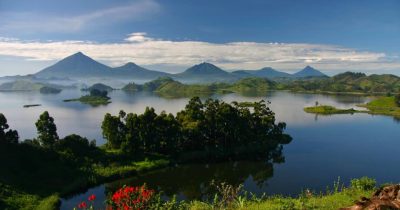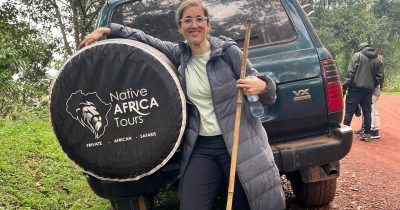Why Spring Is a Great Time for Gorilla Trekking in Uganda
Uganda Gorilla Trekking in Spring! Spring is one of the prime seasons for experiencing Uganda’s Gorilla Trekking safaris. The occasional light rain revitalizes the earth, causing flowers and trees to blossom, transforming Mother Nature into a vibrant spectacle of green and color. Bwindi’s red stinkwood, Newtonia buchananii, and Symphonia globulifera unfurl their new leaves, while various flower species begin to bloom. Trekking among the Giant Apes during this season offers visitors a lush, green forest, as the rains invigorate the ecosystem.
The dynamic climate in Uganda’s Bwindi and Mgahinga Gorilla National Parks significantly contributes to its biodiversity. Changes in temperature and rainfall patterns majorly impact gorilla trekking locations throughout the year.
The rainy season, which is spring, features heavy downpours. These distinct seasonal changes are essential for regulating the environment and influencing the behavior of the Giant Apes, which are among the resident species. The increased rainfall leads to a lush, green forest, invigorating the ecosystem and making it an ideal time for gorilla trekking.
The spring, also known as the rainy or wet season, generally lasts from March to May and October to November. During this period, vegetation flourishes and becomes denser, and the forest floor often turns muddy and slippery, especially in areas prone to flooding near streams and swamps. The transition from spring (rainy) to summer (dry season) leads to notable changes in the ecosystem.

What to Expect during Gorilla Tracking in Spring
First, the breathtaking landscapes of Bwindi Impenetrable Forest and Mgahinga Gorilla National Park serve as a remarkable showcase of natural beauty, enchanting visitors year-round. However, while the park is thrilling at any time, the rainy season (or spring) reveals a unique charm and magic. This time of year awakens sound, color, and a vibrant synergy of life that weaves into a striking tapestry, promising a truly unique and enchanting experience that intrigues and excites you.
The lowered costs for gorilla trekking, increased availability of gorilla permits, revitalization of flora and fauna, and stunning flower blooms provide an ideal backdrop for photography, resulting in a captivating and evocative gorilla trekking experience in Uganda during spring.
Shorter gorilla trekking experiences
During the spring and wet season, cooler temperatures and abundant vegetation, which boost food availability, lead most mountain gorilla groups in Bwindi to remain near the forest edge. This location offers easier access to food and shelter, making them more visible. Some gorilla trekking experiences have lasted as little as one or two hours in the rainy season.
Reduced cost of gorilla trekking
Visitor interest in Uganda Gorilla tours typically declines in Spring (the rainy/wet season) due to unfavorable weather conditions in the parks. As a result, excellent deals are available, particularly with reduced prices for accommodations. This makes spring an ideal time for budget-conscious travelers to embark on a gorilla trekking adventure, making you feel financially savvy and confident in your decision.
The images of shimmering tree canopies, lowered gorilla trekking expenses, and birdwatching meditations will encourage you to book these tours in Spring. This season offers the best opportunities for securing great gorilla trekking deals, especially on accommodation, alongside fewer tourists.
Many Safari Lodges provide off-season promotions or package deals during the wet months, making this an appealing time for travelers seeking an unforgettable gorilla trekking experience at potentially lower costs.
Availability of gorilla permits.
One thing you can be sure of during your Uganda Gorilla Trekking in Spring is the availability of gorilla permits. They are usually readily available, ensuring you can plan your adventure without worrying about permit availability. This abundance of permits provides security and flexibility for your travel plans, giving you a sense of reassurance and peace of mind.
The Uganda Wildlife Authority issues over 200 gorilla permits daily for Bwindi Impenetrable and Mgahinga Gorilla National Parks. Since fewer individuals are booking gorilla safaris, there’s a greater chance of securing permits, even with last-minute bookings. Even if you buy permits a month in advance, there should still be ample gorilla availability. Furthermore, lodging options tend to be more plentiful in Spring, allowing visitors to take advantage of favorable booking conditions and special promotions.
Unforgettable photography opportunities
The steady rain in Bwindi Impenetrable Forest and Mgahinga Gorilla National Park amplifies the natural allure of the jungles, providing an ideal opportunity for photography enthusiasts to capture the vibrant greens and captivating landscapes. These rains also stimulate the growth and flowering of various plant and flower species, resulting in a stunning showcase of the forests’ biodiversity.
Secluded gorilla trekking experiences with fewer crowds
Spring is ideal for travelers who welcome a little rain and seek a peaceful getaway in two of the Earth’s most biodiverse regions. This season is beautiful for individuals desiring quieter, more introspective gorilla trekking adventures in the jungles and at the Safari Lodge, away from crowded tourist times.
Essential Tips for Tracking in Spring
If you intend to experience Uganda Gorilla Trekking in Spring, here are some tips to enhance your adventure:
- Dress in light, comfortable, and waterproof clothing: Always remember that Bwindi Impenetrable Forest and Mgahinga National Park have high humidity. Therefore, wearing light, comfortable, and quick-drying attire is advisable for better mobility while looking for the Giant Apes. A waterproof rain jacket and durable hiking boots are ideal companions for gorilla trekking excursions.
- Insect protection: Rainy weather attracts insects, so it’s wise to bring insect repellent and wear clothing covering most of your skin. However, don’t let concerns about mosquitoes overshadow your gorilla trekking adventure.
- Comfortable and well-fitting shoes: For your gorilla trekking adventures, it’s wise to bring sturdy, comfortable hiking boots that fit well, especially for navigating muddy areas. Including gaiters will enhance your experience and make the tour memorable.
- Maintaining adaptability: Gorilla trekking experiences demand flexibility so that one can fully enjoy what Bwindi and Mgahinga offer, no matter the challenges encountered.
About Uganda Gorilla Trekking
Uganda is a crucial place to mention for gorilla trekking because it is the epicenter for these adventures. It features two prominent natural habitats for mountain gorillas: Bwindi Impenetrable and Mgahinga Gorilla National Parks. Uganda has the world’s highest density of these endangered primates. Bwindi, the larger park, is home to over 480 of the 1063 mountain gorillas recorded in the 2018 census. The park is organized into four trekking sectors, each housing different populations of gorilla families. Mgahinga Gorilla National Park is part of the Greater Virunga Conservation Area, which also includes Rwanda’s Volcanoes National Park and the Virunga National Park located in the eastern part of the Democratic Republic of Congo. Collectively, these parks are home to over 25 habituated gorilla families, allowing for the issuance of 200 gorilla permits each day (with each habituated family permitting eight visitors).
Furthermore, each gorilla trekking region offers unique accommodation options, which should be reserved according to the specific tracking sector. While guests can stay in one industry and trek in another (about an hour’s drive apart), early planning is recommended. Despite common misconceptions, spring is an excellent time for Uganda Gorilla Trekking tours. This season provides secluded trekking experiences with fewer crowds, potential discounts on accommodations, availability of gorilla permits and lodging even last minute, and remarkable photography opportunities.













